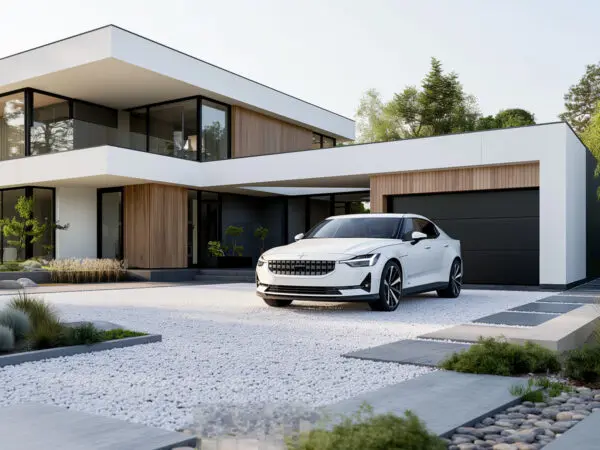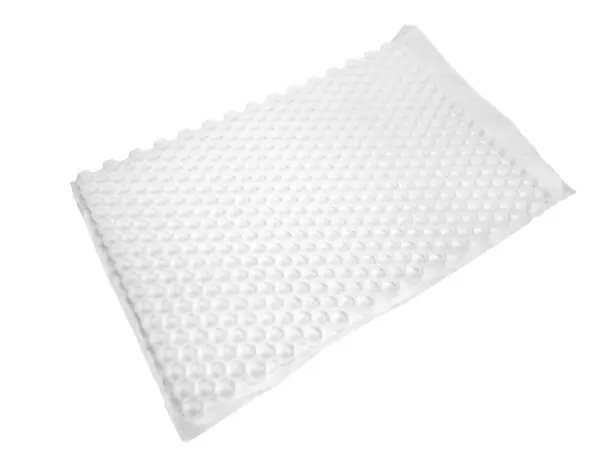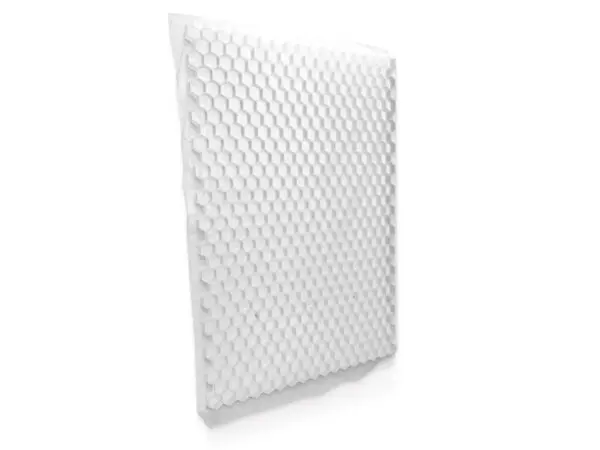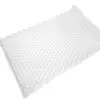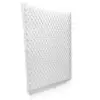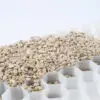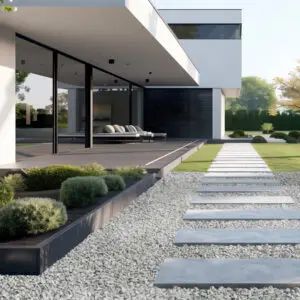CREAgravel 30 gravel grids are innovative solutions designed to provide a stable and robust base for gravel surfaces. Made from 100% HDPE, these grids are laid under the gravel to create a solid base that prevents displacement, subsidence and uneven surfaces. Ideal for driveways, paths, car parks and landscaping projects. Some advantages of gravel grids include:
- Improved stability: By locking the gravel in place in the honeycomb structure, gravel grids provide a stable surface that can withstand heavy loads and traffic without shifting.
- Improved drainage: The open structure of gravel grids ensures efficient water drainage, reducing the risk of puddles and erosion.
- Easy installation: Gravel grids are designed for easy and quick installation, making them perfect for DIY projects.
- Aesthetic appeal: The clean and attractive look of gravel surfaces maintains a neat appearance of your outdoor space.
Whether you want to improve the durability of your driveway, create an attractive garden path or improve the functionality of your car park, CREAgravel 30 gravel grids offer a versatile and practical solution.
Belgian quality product
CREAgravel gravel grids are produced entirely in Belgium. This allows us not only to deliver quickly, but also to carry out strict quality controls. This ensures that our gravel grids offer the best solution for every application!
Frost-resistant gravel grids in HDPE
CREAgravel gravel grids are frost-resistant plates made of HDPE (High-Density Polyethylene). These gravel stabilisation grids remain flexible even at temperatures down to -20°C. Gravel grids made of other materials can break at cold temperatures, but HDPE offers a reliable solution here.
High pressure resistance
CREAgravel gravel grids have a pressure resistance of 400 tonnes/m² when filled. Unfilled, the plates can withstand a pressure of 90 tonnes/m². This high pressure resistance makes the gravel grids perfect for applications such as driveways or car parks.
High torque resistance
Besides pressure resistance, torque resistance is also important. When driving over the gravel grids, especially when manoeuvring, torsion is exerted on the surface. Thanks to the composition of HDPE, CREAgravel gravel sheets remain flexible and will not break or deform. Moreover, the plates feature plastic reinforcements between the honeycombs to increase torque resistance.
Extremely strong geotextile
The composition of the weed membrane (geotextile) has also been given great attention. This fabric prevents pebbles from getting underneath the plate. CREAgravel’s geotextile is 100% bonded and made of polyester, a very strong material. Thanks to its open structure, rainwater can quickly seep to the subsoil, keeping your gravel paving clean. Moreover, plants and grasses cannot attach as easily, which limits weed growth.
CREAgravel gravel grids create a permeable paving with a natural look. The combination of the water-permeable geotextile and the sturdy honeycomb structure prevents ruts and puddles, windblown dust and ensures that the gravel does not shift or end up under the gravel grids after installation. These gravel grids are versatile:
- Terraces
- Walkways and garden paths
- Driveways
- Parking spaces
- Roof terraces
- …
By placing the grids under the gravel, you get a stable surface that is walkable and passable, even with a bicycle, wheelchair or pram and in all weather conditions.
Installation manual for CREAgravel gravel stabilisation grids
The installation of CREAgravel gravel stabilisation grids is simple and quick. For optimal results, first accurately determine which type of plate you need and choose the right foundation depth.
Equipment
- Spade
- Border stones
- Plate compactor
- Grinder
- Shovel
- Broom
- Rake
- Floor squeegee
- Gloves and protective clothing
- Limestone chippings, porphyry chippings or crushed concrete rubble (for foundation layer)
- Limestone, porphyry or screen sand (for levelling layer)
- Gravel
Step 1: Excavation
- Perform the necessary excavation work and always remove the top layer of topsoil.
- Dig to a depth of about 30-35 cm for applications with cars and 20-25 cm for applications without cars.
Step 2: Installation of coping stones
- Position the border stones so that they extend 2 cm above the level of the top of the gravel plate.
- Make sure the border stones are firm and straight.
Step 3: Application of foundation layer (only when vehicles are used)
- Apply a foundation layer at least 25 cm deep.
- Work in layers of no more than 20 cm and compact each layer with a plate compactor.
- Use materials such as limestone chippings, porphyry chippings or crushed concrete rubble (grain size: 0-32 mm or 0-40 mm).
- Avoid brick rubble, as it pulverises over time.
Step 4: Application of levelling layer
- Apply a levelling layer of fine gravel, vibrate it and level the surface.
- For applications with vehicles, the layer is 5 cm deep, without vehicles it is 15 cm deep.
- Use limestone, porphyry (grain size: 2-4 mm, 1-3 mm or 0-4 mm) or sieve sand.
Step 5: Installation of CREAgravel gravel plates
- Lay the CREAgravel grids with overlapping geotextile.
- Cut the plates to size with a grinding wheel (wear gloves and protective clothing when doing so).
- Lay the plates in stretcher bond.
Step 6: Application of gravel
- Fill the gravel plates with gravel. Avoid vehicle loading before the plates are fully filled.
- Level the gravel with a shovel, broom, rake and squeegee. Do not compact the decorative gravel.
- Allow the gravel to protrude 1 to 2 cm above the plates, depending on the grain size.
- Due to natural compaction, the gravel will still collapse a little. Eventually, the gravel should be just enough to make the CREAgravel plates invisible.
- For vehicle applications, use gravel with a grain size of 8-16 mm.
- Use for applications without vehicles gravel with a size of 4-16 mm.
Step 7: Inspection and levelling
- After a few weeks, inspect the surface and level where necessary.
- Add gravel in places where subsidence has occurred. No further subsidence will occur.
Frequently asked questions (FAQ)
- How deep should I dig?
- For applications with cars: 30-35 cm.
- For applications without cars: 20-25 cm.
- Which materials can I use for the foundation layer?
- Limestone chippings, porphyry chippings or crushed concrete rubble (grain size: 0-32 mm or 0-40 mm).
- How much time does the entire installation take?
- The total installation time can vary, but it is estimated at 8-10 hours.
- What safety measures should I take?
- Always wear gloves and protective clothing, especially when using a grinding wheel.
With these steps and tips, you will ensure a durable and stable gravel solution with CREAgravel gravel stabilisation grids. Good luck!
Characteristics CREAgravel 30
- Plate dimensions (*): 120 x 80 cm
- Plate height (**): 3 cm
- Honeycomb diameter: 43 mm
- HDPE density: 0.95 g/cm³
- Honeycomb material: 100% HDPE – high-density polyethylene
- 100% recyclable: Yes
- Breaking strain empty: ISO 844 – 90 tonnes/m²
- Breaking strain filled: ISO 844 – up to 400 tonnes/m²
Characteristics geotextile
- Material: Non-woven polyester
- Color: White
- Weight geotextile: 50 g/m²
- Adhesion geotextile: Adhesion resistance to honeycomb structure
- Overlap geotextile: on two sides of the plate
- Tensile strength: 65 N/5 cm (EN 29073/3)
- Tear strength: 70 N (DIN 53363)
Mechanical properties
- Flexibility: Very high
- Chemical stability: Very high
- UV stability: In case of long-term exposure: yes / when stored indoors: n/a
- Coefficient of thermal expansion: N/A (forces of expansion are absorbed by the flexibility of the plate)
- Low temperature behaviour: retains its flexibility
Practical properties
| Height (**) |
Length x Width (*) |
m²/plate |
gravel/m² |
| 3 cm |
120 x 80 cm |
0.96 |
65 kg |
* a tolerance of about 2% ** a tolerance of about 1.5 mm


